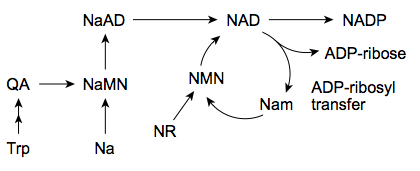Logic, been thinking about your theory and the ribose side of the equation. Only I don't think the NR is reduced or cleaved as you suggest. See the conclusions in this 2012 and the following 2014 studies which were based on oral administration.
The NAD+ precursor nicotinamide riboside enhances oxidative metabolism and protects against high-fat diet induced obesity
"Furthermore, NR protects against metabolic dysfunction at lower concentrations than those reported for NMN and we proved that it is effective after oral administration when mixed with food, which is in contrast to NMN which is injected intraperitoneally (Yoshino et al., 2011)." Who would have thought oral administration of (NR) could beat out injection of NMN? Is this what the data is truly saying?
Effective treatment of mitochondrial myopathy by nicotinamide riboside, a vitamin B3
"We demonstrate here that oral supplementation with NR, a vitamin B3 form and NAD+ precursor, efficiently prevented development and progression of mitochondrial myopathy in mice. NR delayed the development of morphological hallmarks and ultrastructural changes in mitochondria and resulted in a remarkable induction of mitochondrial biogenesis and oxidative metabolism"
"We administered 400 mg/kg/day of NR, or chow diet (CD), for two groups of male Deletor and control mice (Yang et al, 2007; Canto et al, 2012): “pre-manifestation” (12 months at initiation, 16 months at termination), to test whether early NR treatment can prevent MM, and “post-manifestation” (17 months at initiation, 21 months at termination), to test whether NR can affect the progression of an already-manifested disease. The control groups received similar chow diet without NR. The dose and study protocol were exactly as published previously (Canto et al, 2012), because they showed that this dose of NR efficiently increased NAD+ in skeletal muscle."
Here are some insights into what may be happening to the ribose in a recently discovered pathway which seems tissue specific. Something has got to be making this pathway more potent than the typical salvage pathway for NMN. The data just doesn't outline it completely maybe there are other studies that do spell it out.
http://www.uniprot.org/uniprot/Q9NPI5
http://citeseerx.ist...10.1.1.129.1026
http://www.pathwayco...d2.do?id=117650
"The use of NR as a precursor in mammalian cell types was first demonstrated in DRG neurons, which induce the NRK2 transcript when damaged by axotomy (71). The ubiquitous expression of Nrk1 in mammalian tissues (80) sug- gests utilization of NR and/or NaR (83) in a diverse array of cell types. However, Nrk2 is present in heart, brain, and skeletal muscle, and is notably absent in kidney, liver, lung, pan- creas, and placenta (48, 71). The fact that DRG neurons cannot be protected from damage induced neuropathy by Na or Nam without concurrent gene expression of Na or Nam sal- vage genes suggests that NR is a uniquely use- ful precursor to the nervous system (71) when de novo synthesis of NAD+ from Trp is not sufficient. "http://biochem.uiowa...nts/bogan08.pdf
Its widely accepted that the Tryptophan de novo eight-step pathway is a 60 to 1 conversion ratio some studies peg it higher at 67:1 but this may be do to other nutritional factors. So barring huge Tryptophan ingestion which seems to hit all the tissues if you want to feed the tissues Niacin cant NR is up to the job and at higher efficiencies. "utilization of NR by neurons may provide qualitative advantages over niacins in promoting function in the central and peripheral nervous system."
So what I'm getting is NR is superior in specific tissues can be taken at higher doses than either of the other 2 Niacins and it does not have the inhibitory effect on sirtuins like NAM. "the specific utilization of NR by neurons may provide qualitative advantages over niacins in promoting function in the central and peripheral nervous system."
Call to action:
Is there a chart anywhere comparing all the NAD Precursors? If there isn't we need to put one together outlining oral absorption, tissue specific absorption/bioactivity, sirtuin interaction with an overall ranking at tolerable doses.
























































